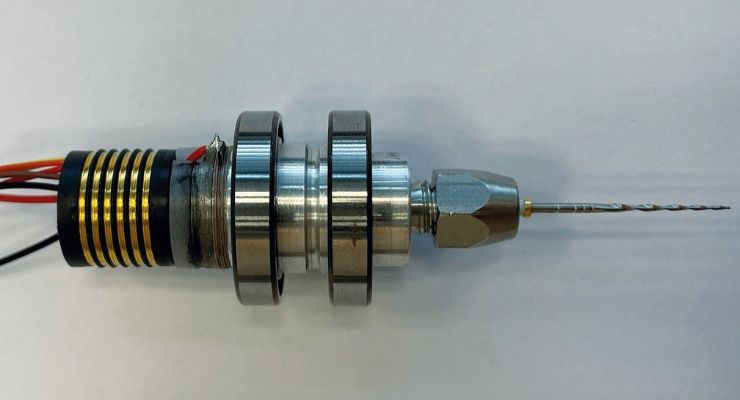Piezoceramics Could Shorten Root Canal Treatments
By Sam Brusco, Associate Editor | 11.13.23
Fraunhofer researchers developed a piezoceramic stack actuator that overlays a dental file’s rotation with axial vibration.
Researchers at Fraunhofer IKTS in Dresden have created a tiny, piezoceramic stack actuator that overlays a dental file’s rotation with axial vibration in the ultrasonic frequency range, in order to shorten root canal treatments. Fraunhofer IKTS will present a demonstrator at the joint Fraunhofer booth at the COMPAMED in hall 8a, booth G10.
A standard dental file rotates about 200 times a minute in its handheld device. It’s inserted into the root canal and periodically removed and inserted—part of the tissue removed becomes a sticky mass attached to the file, reducing cleaning ability and placing strain on the tool. There’s higher risk of the files breaking when they’re under stress, so they must constantly be removed and cleaned.
“By overlaying the rotation with axial vibration, the file gets clogged less quickly, meaning that it doesn’t need to be cleaned so often,” Dr. Holger Neubert, department head of smart materials and systems at Fraunhofer IKTS, told the press. “Dentists are then able to concentrate much more on their complex work in the root canal. The risk of the file breaking is also reduced.” For patients, this means that their root canal treatment is over much faster.

The function demonstrator will be presented at the Fraunhofer booth at Compamed in Düsseldorf.
“The core idea of combining the two motions of the dental file came from the specialists at the Department of Dentistry at the Rostock University Medical Center. We used piezoceramic stack actuators as the drive element because they are most able to meet the special requirements for vibration amplitude and frequency, size as well as supply voltage,” Neubert went on.
The small, compact piezoceramic-based actuators, according to the researchers, are easy to control and lose minimal heat. Stack actuators consist of several stacked layers that work together to increase the actuator’s displacement. Due to this, the project scientists could make the handheld device small enough to easily fit into the narrowest spaces in patients’ mouths.
The researchers are also exploring low-frequency, ultrasonic piezoceramic transducers with high penetration depth for tomography. They’ve been compacted so much, they say, that 2,000 of them could be fit in a conventional tomography system. This could allow high-resolution imaging of the body for diagnostics, particularly for dermatology.
“Piezoceramic components can be used in a wide array of applications and, thanks to their compactness and performance, are ideal for medical engineering. We are able to develop custom solutions to suit the needs of individual clients,” Neubert concluded.
A standard dental file rotates about 200 times a minute in its handheld device. It’s inserted into the root canal and periodically removed and inserted—part of the tissue removed becomes a sticky mass attached to the file, reducing cleaning ability and placing strain on the tool. There’s higher risk of the files breaking when they’re under stress, so they must constantly be removed and cleaned.
“By overlaying the rotation with axial vibration, the file gets clogged less quickly, meaning that it doesn’t need to be cleaned so often,” Dr. Holger Neubert, department head of smart materials and systems at Fraunhofer IKTS, told the press. “Dentists are then able to concentrate much more on their complex work in the root canal. The risk of the file breaking is also reduced.” For patients, this means that their root canal treatment is over much faster.

The function demonstrator will be presented at the Fraunhofer booth at Compamed in Düsseldorf.
The small, compact piezoceramic-based actuators, according to the researchers, are easy to control and lose minimal heat. Stack actuators consist of several stacked layers that work together to increase the actuator’s displacement. Due to this, the project scientists could make the handheld device small enough to easily fit into the narrowest spaces in patients’ mouths.
The researchers are also exploring low-frequency, ultrasonic piezoceramic transducers with high penetration depth for tomography. They’ve been compacted so much, they say, that 2,000 of them could be fit in a conventional tomography system. This could allow high-resolution imaging of the body for diagnostics, particularly for dermatology.
“Piezoceramic components can be used in a wide array of applications and, thanks to their compactness and performance, are ideal for medical engineering. We are able to develop custom solutions to suit the needs of individual clients,” Neubert concluded.














